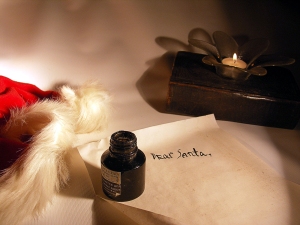Nobody ever thinks that you’re going to send your child to a special school. You know, you don’t wake up and think to yourself, I really hope my child gets into a special school. That’s just not how we are is it? I think I’ve changed.
— Sara James (‘A Place for Us’, Australian Story, 12 August, 2013)

The road to school is paved with good intentions (and a lot of hope)
I recently watched this episode of Australian Story and the above quote from Sara James, mother of a young daughter with a disability, stopped me dead in my viewing tracks.
Because a variation on her words could so easily have been spoken by me about my own little girl, Amelia, who will begin her primary school years at a school for deaf children.
We certainly didn’t think we would end up sending her to anything other than a mainstream school. Going to any other kind of school wasn’t on the list of hopes we had for her before she was born, but like Sara James, I have changed my mind about how I feel about this too.
You see, Amelia’s deafness and autism (and their impact on her development) make it impossible for us to plan her school years more than 6-12 months ahead. Right now, we know where she’ll be next year but after that, it’s hard to be more definite.
The pre-birth notion of mapping out an arrow-straight educational course for her, from attendance at the small local kindergarten in the church hall a few streets away, to the nearby primary school we liked because of its bright, new buildings and wide open spaces is now just a fanciful set of ideas turned to dust.
Thankfully, we didn’t have enough time to really take those places to heart before we understood that for us, and for Amelia, the path of life would never be so clear-cut or sure. We have also worked out that institutional structures won’t always be central to our truest, deepest wishes for her.
What do we care about brand new buildings now, or the ‘best’ scholastic reputations or keeping up with the expectations of others? Not a goddamn thing, because when the goal posts move to the margins you have to start playing a different game – the long game.
It’s funny how far my attitude to this situation of uncertainty has evolved in a period of just two years, as we have adapted to two life-altering diagnoses before Amelia is five years old.
I will never forget the first question that popped into my head when the audiologist at the Royal Children’s Hospital opened the floor to me after we found out that Amelia was deaf: “Will she be able to go to a normal school?”
Normal. I would cringe at that word now, but back then, I seized on it without thinking twice. But in that room, ‘normal’ was just a code for the life I had imagined for Amelia while it slipped through my hands in a matter of minutes.
What I really wanted to know was, “Will she be able to live the life I expected her to have, just like everyone else? Do I dare to hope that despite her deafness (her difference) that her life will be easy enough to navigate? Please, will she be okay?”
I admit it was a desperate grab for a slice of optimism about the future. I’m sure my questions, both articulated and unsaid, are not uncommon to those parents who have found themselves in a similarly dramatic position.
My panicked mind flew years ahead to school because it was an obvious point on our family timeline where I imagined the normality of our lives would truly be tested. Before then, the outcomes for pre-school aged children are much more private and far less scrutinised.
If school age represented a big fork in the road, I didn’t want us to take a hard left while everyone else got to turn right. We’re most of us pack animals at heart, and never more so when trying to slot our children into the ‘safety’ of the herd.
The audiologist reassured me, “Yes, with lots of work on her speech and language, Amelia will catch up by the time she is six or seven. She will be able to go to a mainstream school.” At the time, there was no reason to think otherwise.
So, I clung to that small promise for the next two years. I had to believe that if we just did the tough yards of early intervention and speech therapy and everything else, we would emerge from this temporary blackout and resume normal programming.
But something happens to you over the years of taking your child to appointments and tests and scary places you never thought you’d be. You grow into it, you stop resisting and you begin to accept this life as the real one, the one you were meant to have.
It started in no small way with Amelia’s time at her three-year-old bilingual (Auslan and English) kindergarten run by the Aurora School’s early intervention service. It gave me a chance to see first-hand the benefits of a bilingual learning environment tailored for deaf kids.
Far from emphasising difference, this program offered its charges the security of shared experience. It gave them multiple ways to communicate (sign, speech, gesture), exposure to a wonderful Deaf role model and the freedom to develop at their own pace.
I watched Amelia embrace the visual communication that helped connect her to people, places and things. That kinder year laid some important foundations for her when she needed it most.
By the time she was four, it was clear that Amelia still needed a lot of support to develop her speech, language and social skills. There seemed little point throwing her into the deep end of a mainstream kindergarten three days a week just so I could walk her there and console myself about ‘normality’.
We chose the bilingual deaf kindergarten on our side of the city because it is a 20 minute drive away, and is part of a primary school for the deaf so there’s lots of expertise and support available.
Three of Amelia’s classmates from Aurora joined her there this year, so she’s been able to follow a group of friends through the early stages of school life. In this, we count ourselves very lucky indeed.

Hand up who’s ready for school next year?
Seeing my daughter’s growth in stature and self in this class has filled me with a happiness I did not dare wish for at the start of the year. It is so clear to me that she has found a soft, enriching place to land while being challenged to learn and play in novel and stimulating ways.
At this school, deafness is the baseline, the common denominator. It defines what is the same about her peers, not what is different. It requires no explanation; it is simply understood and catered for in every possible way.
Amelia is talking and signing so much more every day and is fast outstripping her mother’s knowledge of Auslan. She’s even started correcting me when I try to copy a new sign she brings home with her at night. Cheeky little blighter.
My girl will turn five in January next year and I did not think that she would be ready for school, any school, by this age. The recent diagnosis of autism didn’t knock us off a straight line because we’ve never known one. It merely confirmed to us that there is still much work to be done.
I thought perhaps Amelia would repeat another year of kinder, play it safe for a bit and see what the following year might bring. Being a January baby I could have reassured myself that she was entitled to an extra twelve months of development under her belt.
But her marvellous kinder teachers were having none of this overly cautious, pessimistic stuff. It is their strong belief, and I do have faith in their opinion, that Amelia is ready to make the leap to the big kids’ part of school.
It helps that our paediatrician and child psychologist support this assessment and agree that a bilingual school for deaf children is the best place to ‘super-charge’ her progress.
Although this decision made me a little nervous, I couldn’t feel more supported by all of the people who count. I soon realised how low risk our choice was while paving the way for so many benefits and rewards.
I took a tour of the primary school and current Prep class last week and discovered it has four children with the teaching shared by two people (one deaf, one hearing). Not fourteen kids or ten. FOUR.
I had heard that the numbers were small but I had no idea just how optimally low they would be. The numbers are capped at eight, but five is usually the highest number. Now that’s a teacher-pupil ratio we can all live with.
The school already has a number of children who are both deaf and autistic so there is plenty of built-in specialist support on the spot and ready to go.
The primary school children have weekly speech therapy sessions and start to learn more formally about deafness and Deaf Culture among the other programs like art and sport and music that make up the curriculum.
What this unique context means for Amelia is that despite her less-than-perfect start to life, at five she will be able to go to school with a handful of friends, one of whom she has known since she was three. They are a tightly bonded group and it’s thrilling to see them advance together.
Money can’t buy the kind of confidence and self-esteem that comes from progressing with your peers from one milestone to the next, no matter what your individual challenges might be.
In a specialised setting like this, every child gets a chance to grow and move on and up.
If the next 12 months are principally about taking stress off Amelia’s shoulders and helping her to realise her potential, then I couldn’t really think of a more suitable place for her to be.
No mainstream school with all the best intentions, good will and deaf-friendly technology can give her the same guarantees of security and personalised support, particularly at this most crucial time.
I do not see this choice of a school for the deaf as a compromise or as something below par, as I might have two years ago. We are choosing the right school at the right time for our daughter and her needs. Our family feels incredibly fortunate to be able send Amelia there.
If you’d asked me back in 2011 if Amelia would be starting school in 2014 and where she would be going, I would have answered, “I just don’t know.” But here we are, with our collective bags packed with books and excitement, ready for school next year. Prep is a happening thing.
So, I’ve opened my mind and my heart a little bit more, just a touch, to let in the dreams that Amelia’s ascension will bring. She will stand on our porch in her red and blue school uniform and have her photo taken and maybe I’ll surprise myself and be one of those mums who cries on her first day.
Or maybe not. But who even cares? Because my beautiful girl’s going to school, and baby that is a wonderful thing.
Further reading:
The brilliant Aussie Deaf Kids website has an informative overview of the types of schools available to families of deaf children. The general section on primary school is also a valuable one for parents with children entering into this stage of learning.























